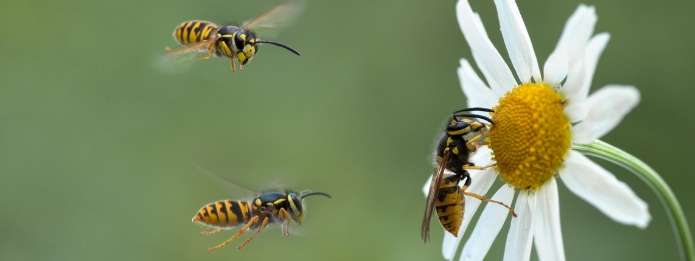How Wasps Communicate with Each Other

Summer is the best time to enjoy a picnic outdoors, but it’s also the time where one wasp suddenly seemed to turn in to a hundred disrupting a perfect day. You may be thinking that they raised some sort of alarm among them. We find ourselves in many situations where the only plausible answer is that the wasps must have communicated with one another. Well, you’re right. They don’t use the traditional communication methods you might assume they do, but wasps are certainly capable of communicating with one another to share important details. Unfortunately, if you give them every opportunity to communicate about your home, you could end up with a serious wasp control problem.
How Do Wasps Communicate?
So if they can’t bark, howl, sing or speak, how do wasps communicate with one another? It’s difficult to imagine, but wasps communicate in a few different ways.
The most common way that wasps communicate is by releasing and smelling pheromones. Odorless to humans and a sign of danger to other insects, these potent chemicals can be coded to communicate a huge range of things. They’re used to mate, to protect their home, and to leave messages regarding food sources. The chemical which is released has a very strong smell and other wasps understand its significance by smelling it.
Recent research has also shown that wasps can communicate by tapping their stomachs. This ‘gastral drumming’ is a relatively new scientific discovery, suggesting that wasps bang their abdomen against the walls of the nest to communicate with their family. Different rhythms and drumming patterns can indicate different things, including the location of a food source and the quality of it. Historically, this was understood to be a sign of hunger, but new evidence suggests it’s another highly advanced method of insect communication.
Why Do They Need to Communicate?
Like the rest of us, wasps need to communicate for a variety of reasons. Most importantly, when a wasp nest is under attack, or if they sense impending danger, they need to communicate fast and retaliate in numbers in order to protect it. Their nest is their home and they will have invested a lot of time in constructing the rather delicate structure.
If humans, animals or any other large mammals get a little too close, they’ll sting the attacker in order to protect themselves and their home. When they sting – and they can do it multiple times – they release those pheromones again. This time, the chemicals communicate to other wasps that they’re under attack, so it is effectively raising an alarm. If your problem wasn’t bad enough, it’s about to get an awful lot worse as more and more wasps arrive to defend their fort.
Wasps also need to communicate to reproduce; pheromones are essential to the mating process. The male wasp releases his pheromones into the atmosphere and if any females pick up on its scent, they’ll be aware of his location and that he’s ready to mate. Different wasp species blend these chemicals in different ways, so the female will know when she’s found the right one.
They will also use these communication methods around your home. If wasps find a good food source in your garden, they’ll use pheromones to leave a trail for other wasps to follow. If they find a suitable location in your home for laying eggs, again, they’ll mark it for other wasps with pheromones.
You won’t know it or be able to smell it, but your home and garden could be infested as a result of this advanced wasp communication. At Truly Nolen, our experts know what to look for. We’ll take care of your wasp control needs and leave you pest free.